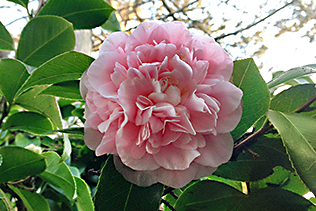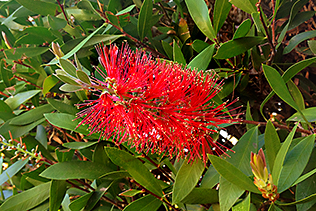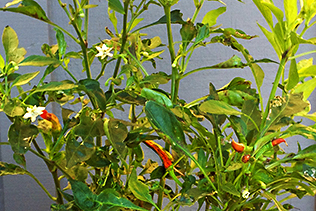"For man, autumn is a time of harvest, of gathering together. For nature, it is a time of sowing, of scattering abroad."
– Edwin Way Teale
12/2/16:
The first camellia flower of our cold season has appeared, on a tall bush near our bedroom window. There are many other buds on this plant and on 3 of the others, but I recall that sometimes they remain unopened until February or March, so I was surprised to see a lovely full bloom this week.
One of these days I'd like to figure out which varieties of camellias I have (apparently there are over 250 species!) So far I think that some of our magenta-flowering ones are Camellia sasanqua 'Bonanza', and this early-blooming pale pink one could be Camellia japonica 'Debutante'. I want to identify the yard's rosebushes also, eventually.
All the camellias are sizable shrubs, planted in the ground between a fence and our house. These and other large plants on the property don't get as much of my attention as the potted flowers, vegetables and herbs that need watering and feeding more frequently. But I've given the flowering hedges some organic fertilizer about 4 times this year, which does seem to affect the bloom cycles and speed up growth in general.
I've discovered that many plants thriving in our coastal climate have Mediterranean origins (such as my favorite cooking herbs). Camellias are from eastern and southern Asia, and the bottlebrush (Callistemon citrinus) is one of several common plants in California gardens that's originally from Australia. While gardening with only native plants can be beautiful and is a popular choice around here, I personally enjoy the variety of species from around the world that can flourish in my yard.
Clicking on the small images below will bring up a larger version.
 Camellia.
Camellia.
 Bottlebrush.
Bottlebrush.
 Thai chili.
Thai chili.
The tomato plants are finally expiring. I'll soon pick the last fruit from plants that have withered and turned brown. Cayenne and Arbol peppers are in similar condition, but the leaves on my Thai chili plant are still green and growing. There are also flowers, that probably won't get the chance to turn into peppers; it's too late in the year for the warm temperatures and bright sun these need. Maybe it could continue to produce fruit if I brought it inside at night to avoid any possible frosts?
Wintery nights are starting to arrive. It's gotten down into the low 40s a few times. Most days are still fairly warm, in the 60s, although I need a sweater on early mornings.
My father, a retired geologist, has developed an interest in other areas of scientific study, such as tracking the weather. I didn't used to pay attention to the weather much, and only once in a while would I compare the day's temperature, precipitation or cloud level with previous observations. But over the past 2 years of intensified gardening, I am taking note of local patterns, writing on this topic in letters to Dad, and recording some of it here. While all the reading I do about growing zones and cultivation methods for various plants is a great help, I think records of personal experience of our climate will be even more valuable in my future garden planning.
After finding old seeds in the closet recently, I wondered if any were sprout-able. It turns out that many years-old seeds can still germinate! So this weekend I will re-sow mint, fennel, and the mystery seeds stored in unmarked ziploc bags. I can keep them in seedling pots in the house and in warmer, sheltered areas outdoors. It's time to plant another round of radishes also. These are the only root vegetable that did well this year. I still have parsnip seeds, I'll try again with those if I can find some deeper pots with decent soil. I pulled up the ones planted in March: only one managed to grow a root over 3 inches long.
Other plans for the next few weeks include stacking and storing pots that are now empty of summer's plants, and deadheading the mums once more. I have continued to collect petals from these and other flowers all autumn, and now have a nice variety of them to make more potpourri.







